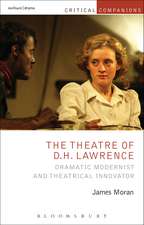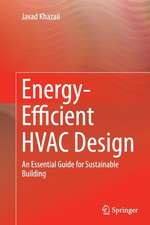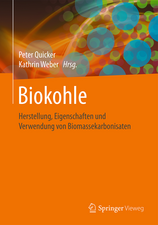Biogas Technology in Southeast Asia: Green Energy and Technology
Autor Pruk Aggarangsi, Sirichai Koonaphapdeelert, Saoharit Nitayavardhana, James Moranen Limba Engleză Hardback – 8 mar 2023
Producing biogas through biodigestion is non-polluting as there is no combustion or energy addition especially in the warmer climes of Southeast Asia. In this region, poorly managed landfills allow toxic liquids to drain into underground water sources. If instead, these wastes were used in a biogas plant, water pollution would be reduced. The same argument could be made for the local air quality. Therefore, biogas generation, in addition to producing renewable energy, also improves local water and air quality. The solid end-waste product of the biogas generation process is enriched natural organic matter (digestate), which can be substituted for chemical fertilizers, providing another environmental benefit to biogas.
This book is primarily concerned with the production of biogas. From the raw material pre-treatment to the reactor design and operation to the post-treatment system, this book covers all aspects of production. There are many types of biogas reactors, each with their own advantages. Which reactor to select depends on the type and quantity of raw material, land area available and climate, among other factors. This book provides information on selecting and operating a suitable biogas system for interested parties bethey governmental, NGO’s, private companies or individuals.
Biogas contains primarily methane (CH4) and carbon dioxide (CO2). It may also contain small quantities of carbon monoxide (CO), hydrogen sulfide (H2S), moisture and siloxanes. Extracting the methane from all other gases is called biogas upgrading and the output is then referred to as biomethane. These upgrading processes are not the subject of this book as they are already the subject of a previously published book.
Din seria Green Energy and Technology
- 18%
 Preț: 943.43 lei
Preț: 943.43 lei - 20%
 Preț: 629.52 lei
Preț: 629.52 lei - 18%
 Preț: 1124.92 lei
Preț: 1124.92 lei - 18%
 Preț: 947.35 lei
Preț: 947.35 lei - 15%
 Preț: 655.92 lei
Preț: 655.92 lei - 18%
 Preț: 957.62 lei
Preț: 957.62 lei - 18%
 Preț: 789.52 lei
Preț: 789.52 lei - 17%
 Preț: 464.55 lei
Preț: 464.55 lei - 15%
 Preț: 645.79 lei
Preț: 645.79 lei - 18%
 Preț: 903.93 lei
Preț: 903.93 lei - 24%
 Preț: 1322.07 lei
Preț: 1322.07 lei - 18%
 Preț: 890.54 lei
Preț: 890.54 lei - 18%
 Preț: 1115.46 lei
Preț: 1115.46 lei - 18%
 Preț: 1117.03 lei
Preț: 1117.03 lei - 18%
 Preț: 949.73 lei
Preț: 949.73 lei - 15%
 Preț: 648.24 lei
Preț: 648.24 lei - 18%
 Preț: 997.09 lei
Preț: 997.09 lei - 15%
 Preț: 579.81 lei
Preț: 579.81 lei - 18%
 Preț: 1123.15 lei
Preț: 1123.15 lei - 18%
 Preț: 961.41 lei
Preț: 961.41 lei - 17%
 Preț: 490.22 lei
Preț: 490.22 lei - 18%
 Preț: 904.60 lei
Preț: 904.60 lei - 15%
 Preț: 643.34 lei
Preț: 643.34 lei -
 Preț: 287.90 lei
Preț: 287.90 lei - 24%
 Preț: 634.04 lei
Preț: 634.04 lei -
 Preț: 379.39 lei
Preț: 379.39 lei - 18%
 Preț: 783.20 lei
Preț: 783.20 lei - 18%
 Preț: 1394.84 lei
Preț: 1394.84 lei - 18%
 Preț: 1691.57 lei
Preț: 1691.57 lei - 18%
 Preț: 1112.48 lei
Preț: 1112.48 lei - 15%
 Preț: 592.61 lei
Preț: 592.61 lei - 18%
 Preț: 952.09 lei
Preț: 952.09 lei - 18%
 Preț: 944.19 lei
Preț: 944.19 lei - 18%
 Preț: 891.33 lei
Preț: 891.33 lei - 18%
 Preț: 1252.44 lei
Preț: 1252.44 lei - 18%
 Preț: 789.52 lei
Preț: 789.52 lei - 20%
 Preț: 566.29 lei
Preț: 566.29 lei - 18%
 Preț: 1113.71 lei
Preț: 1113.71 lei - 18%
 Preț: 1114.24 lei
Preț: 1114.24 lei - 24%
 Preț: 590.58 lei
Preț: 590.58 lei - 20%
 Preț: 566.51 lei
Preț: 566.51 lei - 24%
 Preț: 907.48 lei
Preț: 907.48 lei - 18%
 Preț: 952.89 lei
Preț: 952.89 lei - 18%
 Preț: 952.89 lei
Preț: 952.89 lei - 18%
 Preț: 950.52 lei
Preț: 950.52 lei
Preț: 892.11 lei
Preț vechi: 1087.94 lei
-18% Nou
Puncte Express: 1338
Preț estimativ în valută:
170.72€ • 174.84$ • 142.02£
170.72€ • 174.84$ • 142.02£
Carte disponibilă
Livrare economică 25 februarie-11 martie
Preluare comenzi: 021 569.72.76
Specificații
ISBN-13: 9789811988868
ISBN-10: 9811988862
Pagini: 176
Ilustrații: XXVI, 176 p. 80 illus., 65 illus. in color.
Dimensiuni: 155 x 235 mm
Greutate: 0.48 kg
Ediția:2023
Editura: Springer Nature Singapore
Colecția Springer
Seria Green Energy and Technology
Locul publicării:Singapore, Singapore
ISBN-10: 9811988862
Pagini: 176
Ilustrații: XXVI, 176 p. 80 illus., 65 illus. in color.
Dimensiuni: 155 x 235 mm
Greutate: 0.48 kg
Ediția:2023
Editura: Springer Nature Singapore
Colecția Springer
Seria Green Energy and Technology
Locul publicării:Singapore, Singapore
Cuprins
Introduction to Biogas.- Anaerobic Digestion and Biogas Production.- Reactor Designs.- Pretreatment of biogas input.- Control of Biogas yields.- Processing Biogas Plant Effluent.- Biogas Utilization.- Case study: design a biogas plant.
Notă biografică
Dr. James Moran received a Masters degree and PhD degree in Mechanical Engineering from the Massachusetts Institute of Technology. He is currently an Associate Professor at the Department of Mechanical Engineering in Chiang Mai University. For the past 10 years he has also been a consultant to the Energy Research and Development Institute (ERDI), Chiang Mai University. His research interests include biogas upgrading, biomethane grids, biomethane low pressure storage and meso-scale combustion. Along with his colleagues at ERDI he has published many peer reviewed papers on biogas and a book entitled, ‘Biomethane: Production and Applications’.
Textul de pe ultima copertă
This book on biogas is about the production and use of biogas with an emphasis on the raw materials and processes suitable for use in Southeast Asia. It is a gas formed when organic matter decomposes in an anaerobic digestion process. It can be made from any organic substance but the most economic are organic products from waste such as agricultural or general household waste, sewage, manure, municipal waste or food waste. As this raw material can be renewed indefinitely, biogas produced from it, is considered a renewable energy source. Worldwide interest in renewable energy sources is gathering momentum especially as concern for climate change mounts. Biogas generation helps reduce reliance on the use of fossil fuels.
Producing biogas through biodigestion is non-polluting as there is no combustion or energy addition especially in the warmer climes of Southeast Asia. In this region, poorly managed landfills allow toxic liquids to drain into underground water sources. If instead,these wastes were used in a biogas plant, water pollution would be reduced. The same argument could be made for the local air quality. Therefore, biogas generation, in addition to producing renewable energy, also improves local water and air quality. The solid end-waste product of the biogas generation process is enriched natural organic matter (digestate), which can be substituted for chemical fertilizers, providing another environmental benefit to biogas.
This book is primarily concerned with the production of biogas. From the raw material pre-treatment to the reactor design and operation to the post-treatment system, this book covers all aspects of production. There are many types of biogas reactors, each with their own advantages. Which reactor to select depends on the type and quantity of raw material, land area available and climate, among other factors. This book provides information on selecting and operating a suitable biogas system for interested parties be they governmental, NGO’s, private companies or individuals.
Biogas contains primarily methane (CH4) and carbon dioxide (CO2). It may also contain small quantities of carbon monoxide (CO), hydrogen sulfide (H2S), moisture and siloxanes. Extracting the methane from all other gases is called biogas upgrading and the output is then referred to as biomethane. These upgrading processes are not the subject of this book as they are already the subject of a previously published book.
Producing biogas through biodigestion is non-polluting as there is no combustion or energy addition especially in the warmer climes of Southeast Asia. In this region, poorly managed landfills allow toxic liquids to drain into underground water sources. If instead,these wastes were used in a biogas plant, water pollution would be reduced. The same argument could be made for the local air quality. Therefore, biogas generation, in addition to producing renewable energy, also improves local water and air quality. The solid end-waste product of the biogas generation process is enriched natural organic matter (digestate), which can be substituted for chemical fertilizers, providing another environmental benefit to biogas.
This book is primarily concerned with the production of biogas. From the raw material pre-treatment to the reactor design and operation to the post-treatment system, this book covers all aspects of production. There are many types of biogas reactors, each with their own advantages. Which reactor to select depends on the type and quantity of raw material, land area available and climate, among other factors. This book provides information on selecting and operating a suitable biogas system for interested parties be they governmental, NGO’s, private companies or individuals.
Biogas contains primarily methane (CH4) and carbon dioxide (CO2). It may also contain small quantities of carbon monoxide (CO), hydrogen sulfide (H2S), moisture and siloxanes. Extracting the methane from all other gases is called biogas upgrading and the output is then referred to as biomethane. These upgrading processes are not the subject of this book as they are already the subject of a previously published book.
Caracteristici
Provides detailed knowledge on the rapidly expanding field of biogas production Deals with production systems in South East Asia where the tropical climate suits biogas production Presents real case studies throughout including processes from a technical economic and social perspective






















